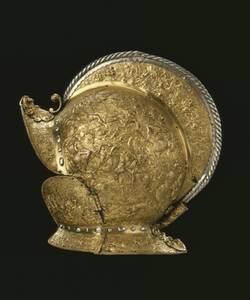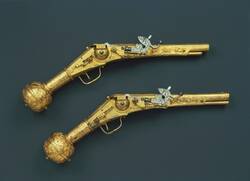While the royal courts of Europe appropriated the glorious past for their own purposes and staged medieval festivals with jousting tournaments and extravagant parades, weapons technology continued to be developed for the battlefields of Europe. Gunpowder had been used in weapons since the second quarter of the fourteenth century – at first in heavy guns that were larger than a grown man, then towards the end of the fifteenth century, in small firearms as well. The wheel lock, invented either in Germany or in Italy, was crucial to the development of hand-held pistols.
The two gilded, embossed, etched and engraved wheel-lock pistols you see here are made from iron and copper. Their surfaces are covered with delicate foliage patterns, ancient horsemen and fabulous creatures.
When they were made, some time around 1590, it was common to produce pistols as identical pairs, sometimes even as double pairs.
They were loaded by thrusting the gunpowder and bullet down the muzzle of the pistol with a ramrod, which was mounted just below the barrel. The soldier would have had several prepared cartridges stored in boxes to protect them from moisture. One cartridge consisted of a pre-measured amount of powder and a bullet, wrapped in a cylinder of paper.
In order to load the pistol, the soldier would tear open one of these small cylinders of paper; first he would put the gunpowder, then the bullet, and finally the paper into the barrel. The striking pommels on the grips of these pistols can be opened. One of them contains tools to clean the barrel.
We don’t know the name of the gunsmith who made these pistols, but they certainly come from Augsburg.
On the octagonal part of the barrel, at the rear, you can see the Augsburg inspection stamp: an orb and a medallion with a crowned male head and the initials K.T. The rich decoration is remarkably similar to that of the gilded helmet, which is also on show here. And we do at least know who ordered that helmet.
It’s the Electress Sophia who once again provides the clue. She commissioned the helmet as a Christmas present for her husband. So, if the pistols and helmet really do belong together, and that seems very likely, the weapons were probably made in 1589, the year Christian received the helmet.

